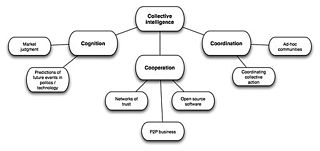Related Research Articles

The Conference and Workshop on Neural Information Processing Systems is a machine learning and computational neuroscience conference held every December. The conference is currently a double-track meeting that includes invited talks as well as oral and poster presentations of refereed papers, followed by parallel-track workshops that up to 2013 were held at ski resorts.
A collaboratory, as defined by William Wulf in 1989, is a “center without walls, in which the nation’s researchers can perform their research without regard to physical location, interacting with colleagues, accessing instrumentation, sharing data and computational resources, [and] accessing information in digital libraries”.
The Natural Language Toolkit, or more commonly NLTK, is a suite of libraries and programs for symbolic and statistical natural language processing (NLP) for English written in the Python programming language. It was developed by Steven Bird and Edward Loper in the Department of Computer and Information Science at the University of Pennsylvania. NLTK includes graphical demonstrations and sample data. It is accompanied by a book that explains the underlying concepts behind the language processing tasks supported by the toolkit, plus a cookbook.
The learnable evolution model (LEM) is a non-Darwinian methodology for evolutionary computation that employs machine learning to guide the generation of new individuals. Unlike standard, Darwinian-type evolutionary computation methods that use random or semi-random operators for generating new individuals, LEM employs hypothesis generation and instantiation operators.

Jacek M. Zurada serves as a Professor of Electrical and Computer Engineering Department at the University of Louisville, Kentucky. He has held visiting appointments at Princeton, Northeastern, Auburn, and at overseas universities in Australia, Chile, China, France, Germany, Hong Kong, Italy, Japan, Poland, Singapore, Spain, and South Africa. He is a Life Fellow of IEEE.

The Center for Advanced Engineering Environments (CAEE) is a department center of the Frank Batten College of Engineering and Technology at Old Dominion University. The center was created in 2001 to serve as a focal point for research activities pertaining to Collaborative distributed Knowledge discovery and exploitation, Interactive visual simulations, Intelligent synthesis, and advanced learning/training technologies and environments, and their application to future complex engineering systems.

Stephen M. Omohundro is an American computer scientist whose areas of research include Hamiltonian physics, dynamical systems, programming languages, machine learning, machine vision, and the social implications of artificial intelligence. His current work uses rational economics to develop safe and beneficial intelligent technologies for better collaborative modeling, understanding, innovation, and decision making.

Tomaso Armando Poggio, is the Eugene McDermott professor in the Department of Brain and Cognitive Sciences, an investigator at the McGovern Institute for Brain Research, a member of the MIT Computer Science and Artificial Intelligence Laboratory (CSAIL) and director of both the Center for Biological and Computational Learning at MIT and the Center for Brains, Minds, and Machines, a multi-institutional collaboration headquartered at the McGovern Institute since 2013.

nanoHUB.org is a science and engineering gateway comprising community-contributed resources and geared toward education, professional networking, and interactive simulation tools for nanotechnology. Funded by the United States National Science Foundation (NSF), it is a product of the Network for Computational Nanotechnology (NCN). NCN supports research efforts in nanoelectronics; nanomaterials; nanoelectromechanical systems (NEMS); nanofluidics; nanomedicine, nanobiology; and nanophotonics.

Collective intelligence (CI) is shared or group intelligence that emerges from the collaboration, collective efforts, and competition of many individuals and appears in consensus decision making. The term appears in sociobiology, political science and in context of mass peer review and crowdsourcing applications. It may involve consensus, social capital and formalisms such as voting systems, social media and other means of quantifying mass activity. Collective IQ is a measure of collective intelligence, although it is often used interchangeably with the term collective intelligence. Collective intelligence has also been attributed to bacteria and animals.
The IEEE Computational Intelligence Society is a professional society of the Institute of Electrical and Electronics Engineers (IEEE) focussing on "the theory, design, application, and development of biologically and linguistically motivated computational paradigms emphasizing neural networks, connectionist systems, genetic algorithms, evolutionary programming, fuzzy systems, and hybrid intelligent systems in which these paradigms are contained".
The computational intelligence and machine learning (CIML) community portal is an international multi-university initiative. Its primary purpose is to help facilitate a virtual scientific community infrastructure for all those involved with, or interested in, computational intelligence and machine learning. This includes CIML research-, education, and application-oriented resources residing at the portal and others that are linked from the CIML site.
The LIDA cognitive architecture is an integrated artificial cognitive system that attempts to model a broad spectrum of cognition in biological systems, from low-level perception/action to high-level reasoning. Developed primarily by Stan Franklin and colleagues at the University of Memphis, the LIDA architecture is empirically grounded in cognitive science and cognitive neuroscience. In addition to providing hypotheses to guide further research, the architecture can support control structures for software agents and robots. Providing plausible explanations for many cognitive processes, the LIDA conceptual model is also intended as a tool with which to think about how minds work.

Eric Joel Horvitz is an American computer scientist, and Technical Fellow at Microsoft, where he serves as director of Microsoft Research Labs, including research centers in Redmond, WA, Cambridge, Massachusetts, New York, NY, Montreal, Canada, Cambridge, UK, and Bangalore, India.
Polish Grid Infrastructure PL-Grid, a nationwide computing infrastructure, built in 2009-2011, under the scientific project PL-Grid - Polish Infrastructure for Supporting Computational Science in the European Research Space. Its purpose was to enable scientific research based on advanced computer simulations and large-scale computations using the computer clusters, and to provide convenient access to the computer resources for research teams, also outside the communities, in which the High Performance Computing centers operate.

The International Conference on Computational Intelligence Methods for Bioinformatics and Biostatistics (CIBB) is a preeminent yearly scientific conference focused on machine learning and computational intelligence applied to bioinformatics and biostatistics.
CIML is the initialism for the Centre d'immunologie de Marseille-Luminy.
Ryszard S. Michalski was a Polish-American computer scientist. Michalski was Professor at George Mason University and a pioneer in the field of machine learning.
References
- ↑ Jacek M. Zurada, Janusz Wojtusiak, Maciej A. Mazurowski,Devendra Mehta, Khalid Moidu, Steve Margolis, Toward Multidisciplinary Collaboration in the CIML Virtual Community, Proceedings of the 2008 Workshop on Building Computational Intelligence and Machine Learning Virtual Organizations, pp. 62-66
- ↑ Jacek M. Zurada, Janusz Wojtusiak, Maciej A. Mazurowski,Devendra Mehta, Khalid Moidu, Steve Margolis, Toward Multidisciplinary Collaboration in the CIML Virtual Community, Proceedings of the 2008 Workshop on Building Computational Intelligence and Machine Learning Virtual Organizations, pp. 62-66
- ↑ Jacek M. Zurada, Janusz Wojtusiak, Fahmida Chowdhury, James E. Gentle, Cedric J. Jeannot, and Maciej A. Mazurowski, Computational Intelligence Virtual Community: Framework and Implementation Issues, Proceedings of the IEEE World Congress on Computational Intelligence, Hong Kong, June 1–6, 2008